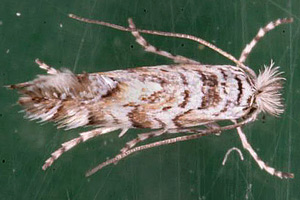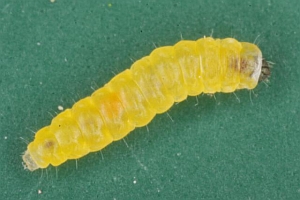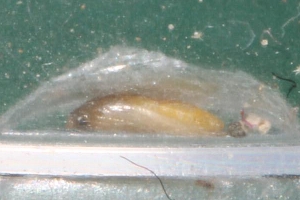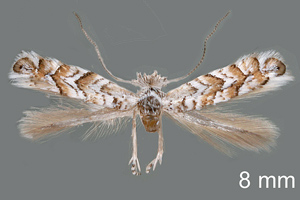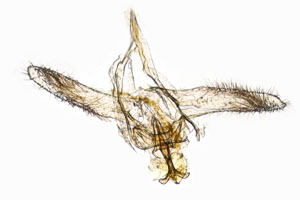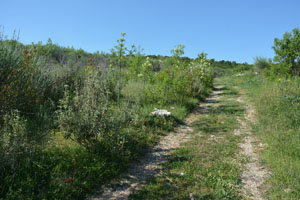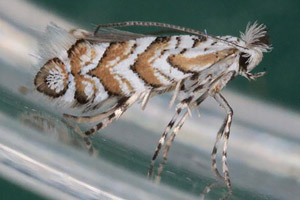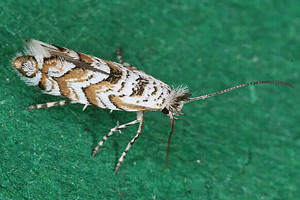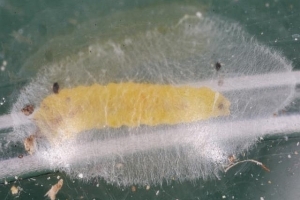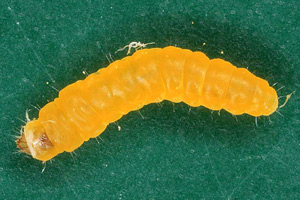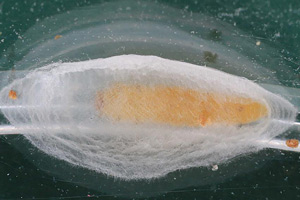1. Lebendfotos
1.1. Falter
1.2. Ausgewachsene Raupe
1.3. Puppe
2. Diagnose
2.1. Männchen
2.2. Genitalien
2.2.1. Männchen
3. Biologie
3.1. Habitat
3.2. Nahrung der Raupe
- [Cistaceae:] Helianthemum nummularium agg. [= Helianthemum vulgare, Helianthemum chamaecistus; inkl. Helianthemum grandiflorum, Helianthemum glabrum, Helianthemum ovatum] (Gewöhnliches Sonnenröschen)
- [Cistaceae:] Helianthemum canariense (Kanaren-Sonnenröschen)
- [Cistaceae:] Tuberaria guttata [= Helianthemum guttatum] (Geflecktes Sandröschen)
Nach Bradley, Jacobs & Tremewan (1970) miniert die Raupe dieser Art unterseitig an Sonnenröschen, nämlich "Helianthemum chamaecistus" und "H. guttatura". Ersteres ist ein Synonym zu Helianthemum nummularium agg., das sich je nach taxonomischer Auffassung als Art in eine Reihe von Unterarten aufteilt (in Mitteleuropa H. nummularium ssp. nummularium, ssp. grandiflorum, ssp. glabrum und ssp. obscurum (incl. var. fruticans)), oder aber in eine Gruppe mehrerer Arten (Helianthemum nummularium s. str., H. grandiflorum, H. glabrum und H. ovatum); in Mitteleuropa ist davon H. ovatum weitaus am häufigsten, H. grandiflorum in den Hochlagen der Alpen und Randgebiete. "H. guttatura" ist eine falsche Schreibweise für H. guttatum, das Gefleckte Sandröschen, das heute allgemein unter Tuberaria guttata geführt wird; die mediterran - submediterran - atlantisch verbreitete Pflanze erreicht Mitteleuropa nur ganz im Nordwesten und Westen. [Beitrag von Erwin Rennwald im Lepiforum]
4. Weitere Informationen
4.1. Andere Kombinationen
- Phyllonorycter helianthemella (Herrich-Schäffer, 1860) [Originalkombination]
4.2. Taxonomie
De Prins et al. (2013) lösten Triberta cistifoliella aufgrund morphologischer Unterschiede aus der Synonymie mit Triberta helianthemella und überführten beide Arten in die neue Gattung Triberta. Und Lopez-Vaamonde et al. (2021: 11) stellten beim Barcoding fest: "Interestingly, DNA barcodes distinguish clearly between species that had previously been synonymized [for instance, Par. alpicola (Wocke)/ Par. scoticella (Stainton); Ph. cerasicolella (Herrich-Schäffer)/ Ph. spinicolella (Zeller); Triberta cistifoliella (Groschke)/ T. helianthemella (Herrich-Schäffer)]. The validity ofall these species is considered confirmed here." Wir haben es hier also mit 2 klar getrennten Arten zu tun.
(Autor: Erwin Rennwald)
4.3. Publikationsjahr der Erstbeschreibung
Wir folgen den Angaben von Heppner (1982) und De Prins & Sattler (2014). Die Fauna Europaea [Version 2.4 — 27 January 2011] gibt hingegen das Jahr 1861 an, De Prins et al. (2013) nannten 1862.
4.4. Literatur
- Lectotypus-Festlegung: De Prins, J., Davis, D. R., De Coninck, E., Sohn, J.-C. & P. Triberti (2013): Systematics, phylogeny and biology of a new genus of Lithocolletinae (Lepidoptera: Gracillariidae) associated with Cistaceae. — Zootaxa 3741 (2): 201-227 [PDF auf www.mapress.com].
- De Prins, J. & K. Sattler (2014): Correction of the publication date of Lithocolletis helianthemella Herrich-Schäffer based on additional data of the taxonomic history of this species (Lepidoptera: Gracillariidae). — Zootaxa 3811 (2): 297-300. [PDF preview auf www.mapress.com]
- Heppner, J. B. (1982): Dates of selected Lepidoptera literature for the western hemisphere fauna. — Journal of the Lepidopterologists' Society 36 (2): 87-111.
- Erstbeschreibung: Herrich-Schäffer, G. A. W. (1860): Neue Schmetterlinge aus Europa und den angrenzenden Ländern. Zweites Heft: 9-20, pl. [10]-[18]. Regensburg (G. J. Manz). — Digitalisat der Bayerischen Staatsbibliothek: [20], [pl. [18] mit fig. 115].
- Lopez-Vaamonde, C., Kirichenko, N., Cama, A., Doorenweerd, C., Godfray, H.C.J., Guiguet, A., Gomboc, S., Huemer, P., Landry, J.-F., Laštůvka, A., Laštůvka, Z., Lee, K.M., Lees, D.C., Mutanen, M., van Nieukerken, E.J., Segerer, A.H., Triberti, P., Wieser, C. & R. Rougerie (2021): Evaluating DNA Barcoding for Species Identification and Discovery in European Gracillariid Moths. — Frontiers in Ecology and Evolution, 9 (Artikel 626752): 1-16.[ [https://www.frontiersin.org/articles/10.3389/fevo.2021.626752/full] zum open-access-Artikel auf frontiersin.org]
- Nel, J. (2014): Atlas des Lépidoptères Gracillariidae Lithocolletinae de France. R.A.R.E. Supplement XXIII.
- [SCHÜTZE (1931): 141]



![Vorkommen in Österreich [Huemer (2013: NR 0643)]](/res/img/flag/at.png)
![Vorkommen in Tschechien [Laštůvka, Z. & J. Liška (2011): Komentovaný seznam motýlů České republiky]](/res/img/flag/cz.gif)

![Vorkommen in Ungarn [Pastorális et. al. (2018): A Magyarországon előforduló molylepke-fajok névjegyzéke]](/res/img/flag/hu.gif)
![Vorkommen in Frankreich (europäisches Territorium ohne Korsika) [Vandromme et al. (2020): Liste systématique et taxinomique des Lépidoptères de France]](/res/img/flag/fr.gif)
![Vorkommen in Spanien (Festland) [Vives Moreno A. (2014)]](/res/img/flag/es.gif)
![Vorkommen auf den Kanarischen Inseln [Vives Moreno, A. (2014)]](/res/img/flag/es-cn.png)
![Vorkommen in Portugal (Festland) [Corley (2015): Lepidoptera of Continental Portugal]](/res/img/flag/pt.gif)
![Vorkommen in Italien (Festland und kleine festlandsnahe Inseln) [Gaedike et al. (1995): Checklist delle Specie della Fauna Italiana 81]](/res/img/flag/it.gif)
![Fragliches Vorkommen auf Sardinien [Gaedike et al. (1995): Checklist delle Specie della Fauna Italiana 81]](/res/img/flag/it-sar.png)
![Vorkommen in Sizilien [Gaedike et al. (1995): Checklist delle Specie della Fauna Italiana 81]](/res/img/flag/it-sic.png)
![Vorkommen in Montenegro [Rudolf Bryner in Lepiwiki]](/res/img/flag/me.gif)
![Vorkommen in Griechenland (Festland und festlandsnahe Inseln) [Gozmany (2012): The Lepidoptera of Greece and Cyprus Volume I]](/res/img/flag/gr.png)
![Vorkommen auf Zypern [Gozmany (2012): The Lepidoptera of Greece and Cyprus Volume I]](/res/img/flag/cy.gif)
![Vorkommen im asiatischen Teil der Türkei [Koçak & Kemal (2018)]](/res/img/flag/tr.gif)
